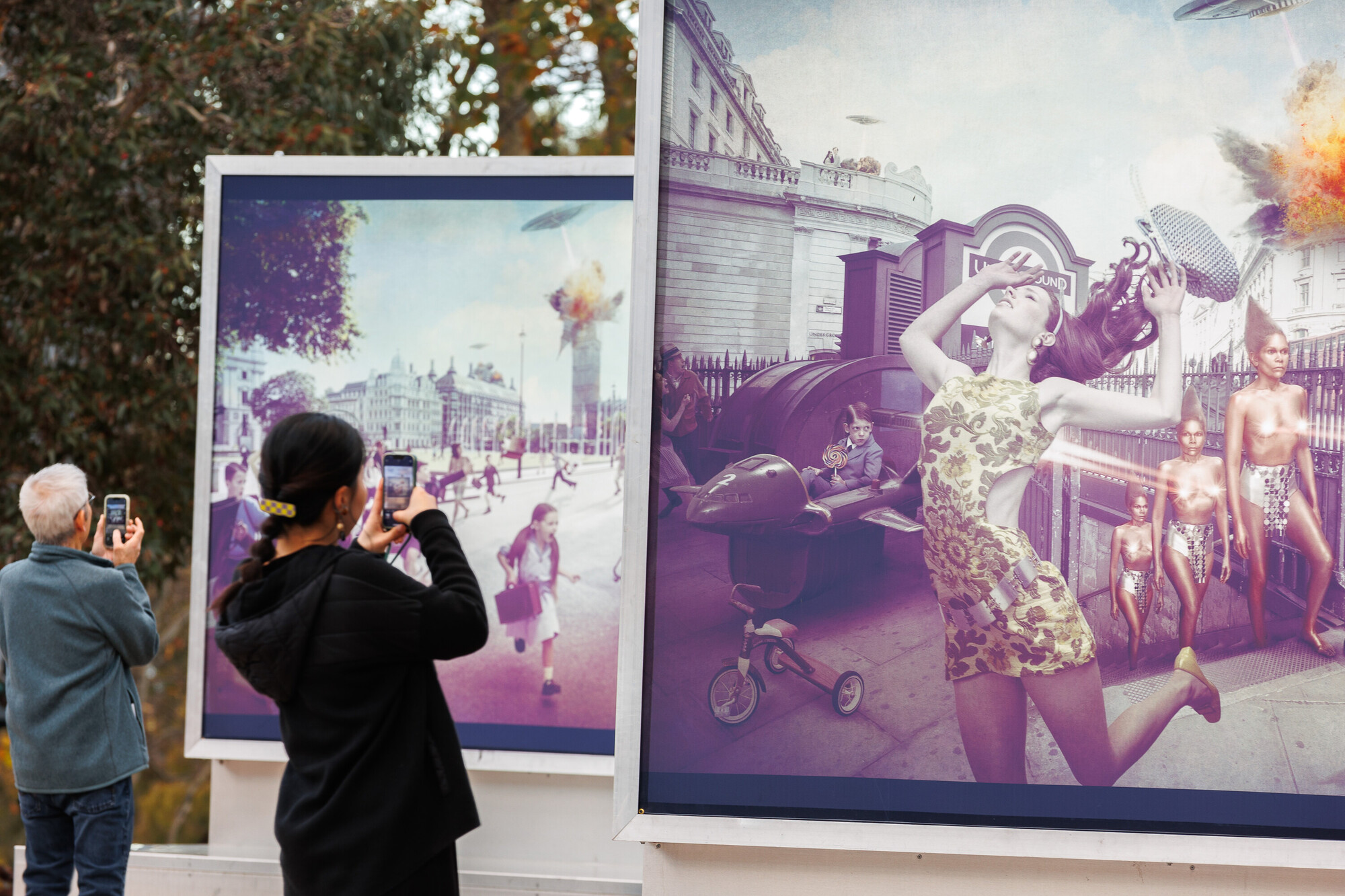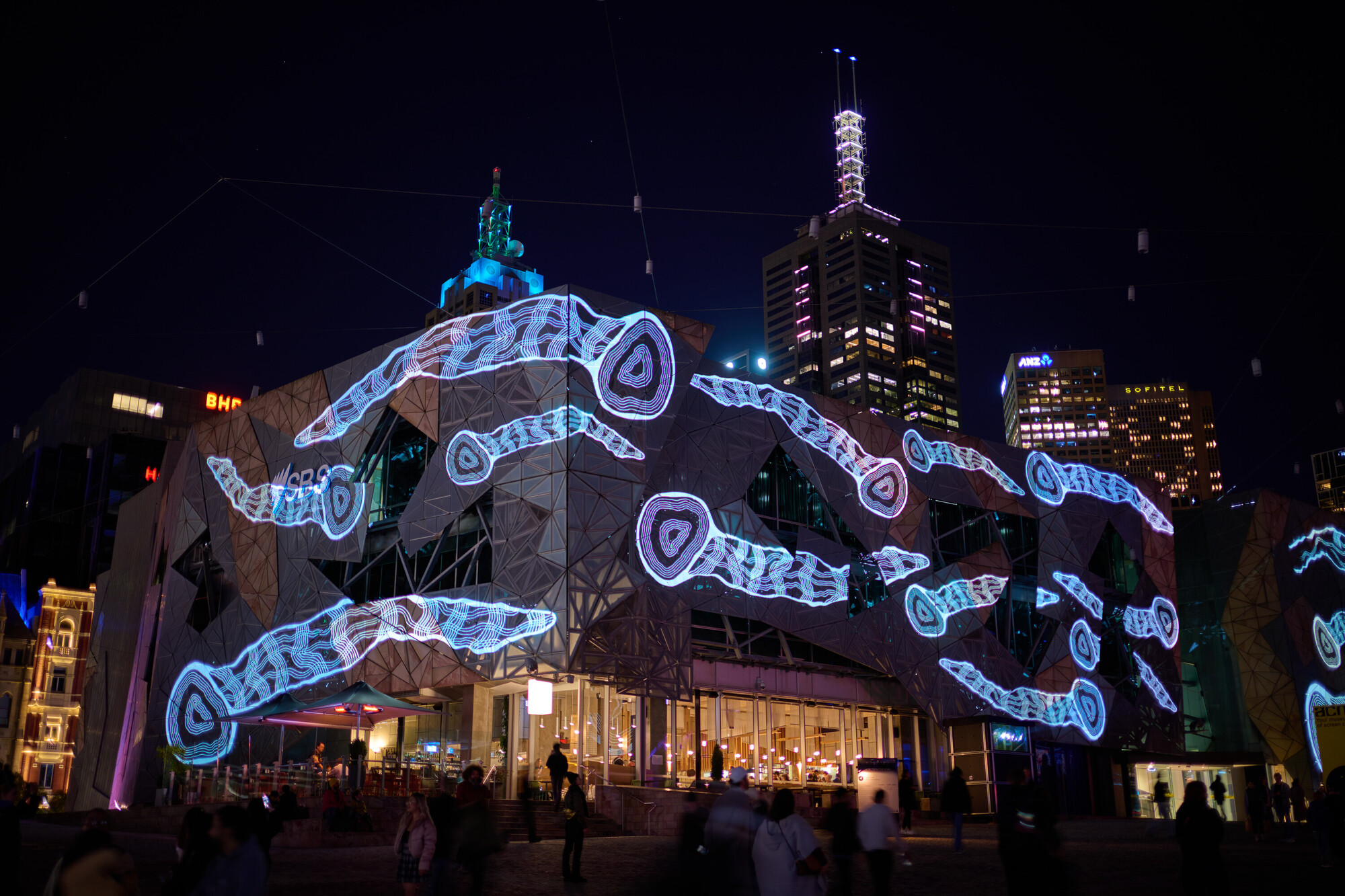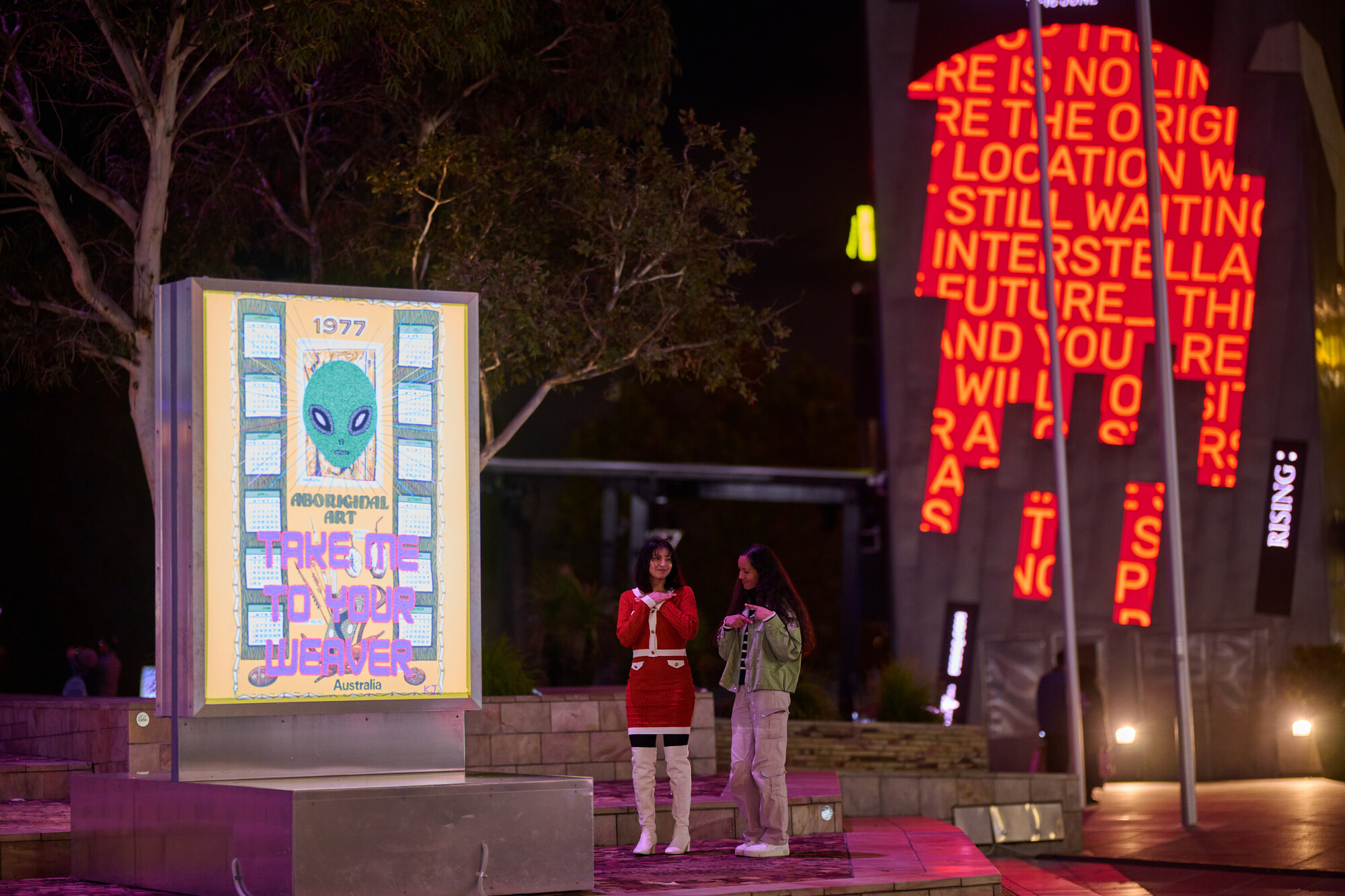Installation view of Ellen van Neervan’s ‘Shoutlines.’ The Blak Infinite, RISING. Photo: James Henry.
The Blak Infinite
Susie Anderson
On my first visit to The Blak Infinite I entered Fed Square’s Atrium from Flinders Street roughly the same time as a group of tourists. Their tour guide wore a Britney Spears-style mic with an orange vest and held up a flag. You couldn’t miss him. Nonetheless, the group splintered as they walked underneath Tony Albert’s mural BEAM ME UP: The Art of Alienation (2024), beckoned by the Atrium’s dappled light toward the giant cartoon cut-out spaceships that form part of his installation.
While the rest of the tour group reconvene by the toilets, I watch a mother and child from the group stop for a photo underneath one of the spaceships’ yellow beams. I guess it does have a gravitational pull. The child contorts their body into a shape like one of the silhouetted figures being abducted by the aliens in their spaceships. I smile as Mum says “yi, er, san,” and the child jumps into the air.

Installation view of Tony Albert and ENOKi, BEAM ME UP: The Art of Abduction. 2024. The Blak Infinite, RISING. Photo: Matt Irwin
BEAM ME UP continues Albert’s 2016 Unalienable series which interrogates the White Australia policy—specifically, the exclusion of Asian migration to Australia—and effectively enshrines racism against any non-white peoples, including Aboriginal people.
This is the context for The Blak Infinite, curated by Kimberley Moulton and Kate ten Buuren for the annual Rising festival. Installations invade what is otherwise a transient public space, a meeting point for people across Narrm and the world. If you want, it’s simply something colourful, fun, and engaging. The mum and daughter have created a memory through their travels. Or if you want more, here’s a set-up for the land you’re on, its known and unknown histories, sent back and forth between past and present. From Albert’s takeover of the Atrium, the exhibition spirals out toward Fed Square proper, with artists Richard Bell, Ellen van Neerven, Kait James, Michael Cook, Josh Muir, Tarryn Love, and ENOKi.

Kimberley Moulton and Kate ten Buuren in front of Richard Bell, EMBASSY (2013). The Blak Infinite, RISING. Photo: TJ Garvie
Groups of school kids sprawl underneath the light boxes displaying Kait James’s artworks. Here she picks up on the invasion and alien themes of Albert’s installation creating playful, kitschy tea towels original message by weaving Space Invaders and Keith Haring figures over the top of Aboriginalia designs of the 1970s. It’s probably because I’m a poet and everything’s a metaphor, but the notion of space invaders seems pretty on the nose as these kids scroll their phones and yell at one another, all bags and jumpers and limbs.
It strikes me that these kids are probably about the same age as Josh Muir when he began making art seriously. His work in the exhibition, Bellow With Pride Don’t Hide (2012), brings me a sense of joy tinged with pain. It fills me with a deep sense of distress that Muir, another young Aboriginal person, and a wonderful artist died much before their time. As the curators acknowledge in their exhibition statement, Muir’s impact on Australian contemporary art and Koorie Victoria was brief but had impact, so much so that a posthumous exhibition is running concurrently at Koorie Heritage Trust.
Michael Cook is known for his atmospheric photographic collages, placing First Nations bodies in contexts that challenge the implicit power dynamics of the setting. Take for example his Majority Rule (2015) series featuring an Aboriginal man in a senate, his body-double sitting in every available chair, or his 2014 project Object, where we see an Aboriginal woman in colonial refinery wistfully duplicated through a ballroom, while a faceless unclad white body holds a bouquet of flowers. His 2017 series INVASION further develops this interrogation of power dynamics, set in London-based cityscapes, where oversized creatures “arrive into urban London, the ‘mother’ country and wreak havoc,” as Louise Martin-Chew puts it. These pictures look somewhat precarious in clunky lightboxes during the day, perched on an incline down towards the Taxi Kitchen and Birrarung Marr. This clumsy execution develops a new element as people walking up the steps to the forecourt of Fed Square become involved in a type of performance: viewers become as diminutive as the figures within the frame. It became an infinite feedback loop of power play. At nighttime these clumsy aluminium shackles are softened by the light from within and the work finds its impact.

Installation view of Michael Cook, Invasion, 2017. The Blak Infinite, RISING. Photo: James Henry
Nearby, Ellen van Neerven’s Shoutlines (2024) is a constant melange of lines in all caps, ticking across the big screen. The quotes scrolling remind me of Water, a story in van Neervan’s debut collection Heat and Light (2014), speculative fiction of queer First Nations histories set in a not-too-distant future Queensland. The author’s work always draws attention to what is possible and what is precious. When I see this work later at night, it’s transformed into yaburuhma dugun (infinite sky) (2024), a video poem of spacious, sweet dialogue between moon and tides. It’s a freezing, misty night, and rain plays in beams projecting back towards Fed Square, as I read the line “this time of wet rough seas” dissolving into “this time of reaching for heat.”
Tarryn Love’s projection casts an ethereal shadow over the shards of Fed Square, with animated eels gently swimming between buildings in an exchange with the nearby Birrarung. Love’s ancestors of the Gunditjmara Keerray Woorroong clan, whose aquacultural knowledge spanned freshwater up to Budj Bim and back down to saltwater at Warrnambool, ensured the natural ecosystems of the lands endured. As I watch these eels swim I think of bodies of water on those lands, currently under threat by offshore energy drilling. I’m struck by the relationship between the original object and its digital reproduction: woven eel traps were designed to degrade over time, just as the projection will fade with the exhibition’s short run time.

Installation view of Tarryn Love, ngaka - look here, 2024. The Blak Infinite, RISING. Photo: Matt Irwin
Richard Bell’s Embassy (2013–ongoing) sits unsuspectingly, yet deliberately, between ACMI and Koorie Heritage Trust. As a continuation of its global tour, Embassy was activated with film screenings during the day and a program of talks each weekend of the festival. During my daytime visit, I watched No Tin Shack (2022), a film that recreates the destruction of the tin shack where Bell grew up (and was subsequently bulldozed), as well as an incendiary video version of his 2002 essay Bell’s Theorem. With trademark insistence, he asks: “Are you willing to give up your public space to Aboriginal art?” and “How much more space will you give to us for our rights?”

The Blak Infinite, RISING. Photo: James Henry.
Unfortunately, I think the answer is given by the Rising festival itself. Granted that “public space” in the settler city is in part the upshot of White Australia policy—which viewed Aboriginal people as a surplus population—and liberal multiculturalism, which depoliticises the economy and recuperates Aboriginal culture (or art) as surplus value, Bell’s question might be slightly redirected. Seeing these works in this civic setting, with transient crowds of ambivalence, searching for a well-serviced public toilet, made me question the stark shift from 2023’s incredible Shadow Spirit, curated by Moulton at Flinders Street Station’s abandoned rooms. If these works had been given a more concentrated space, would they have more impact? Why were the Rising directors inclined towards this diffused public display of Aboriginal art? Why weren’t they compelled to give up more programmatic space for Aboriginal art, to match Shadow Spirit?
Alongside its extended run, six weeks after the official 2023 Rising Festival ended, Shadow Spirit had extensive curatorial text, artist interviews and accompanying audio available online and in the exhibition space. Meanwhile, I had to scrounge for information from the Fed Square website about The Blak Infinite works and discovered that Richard Bell’s Pay The Rent (2022), attached to the facade of the State Library of Victoria, actually formed part of the broader festival program too. An LED sign emanates an insurmountable figure that ticks away and keeps track of the “running total of what’s owed to the First Peoples of this land,” out of context and away from the rest of the artworks.
My admiration and respect for the artists and curators notwithstanding, I had expectations that this would leave me changed, excited, and inspired by the exhibition. Yet I was left wanting more, whether from a more concentrated exhibition space or from the curatorial concept at large. As Jessi Ryan wrote in ArtsHub, The Rivers Sing by Deborah Cheetham Fraillon AO, Byron J Scullin, Thomas Supple (2021)—though not part of The Blak Infinite—also suffered from lack of context. A haunting echo across the city at five-thirty each night, it disturbed many of the people for whom Rising was an unfamiliar concept. I felt this interpretation to be part of its anti-colonial message. Some will be disturbed; some won’t get it at all. Some would hear beauty within the melancholy. I overheard tradies at Flinders Street, who experienced the song daily, wondering about the tech specs of the speakers.

Installation view of Josh Muir, Bellow With Pride Don’t Hide, 2012. The Blak Infinite, RISING. Photo: James Henry
Despite my confusion and the distance I felt with the execution of The Blak Infinite, its artists are united by a sense of confidence and pride. Something deeper and more profound connects them, and their works succeed individually, overshadowing various forms of invasion threatening to disrupt our enduring culture and environments. Hopefully Rising’s directors can secure their much-needed funding to return to a more robust exhibition model in 2025. The Blak Infinite artists might have a few ideas of what the future could look like.
Susie Anderson is a proud Wergaia & Wemba Wemba woman from Western Victoria who writes poetry and nonfiction. Her work reflects on what visual arts practice can tell us about culture, place and memory. Susie’s poetry collection ‘the body country’ was published in 2023 and shortlisted for the Victorian and NSW Premier’s Literary Awards.